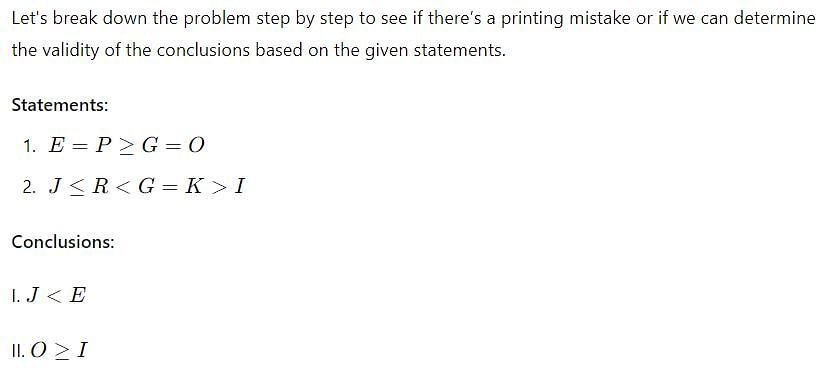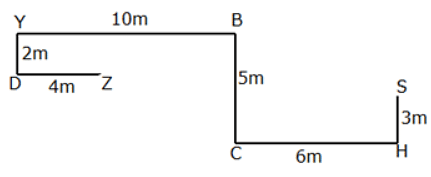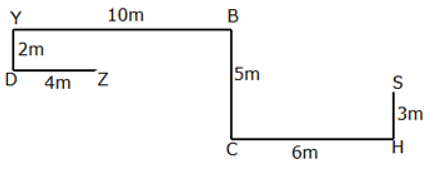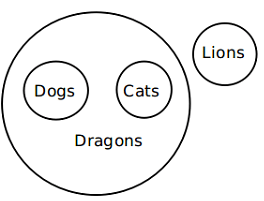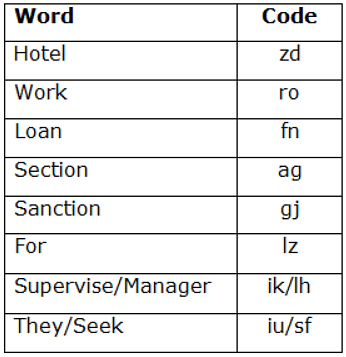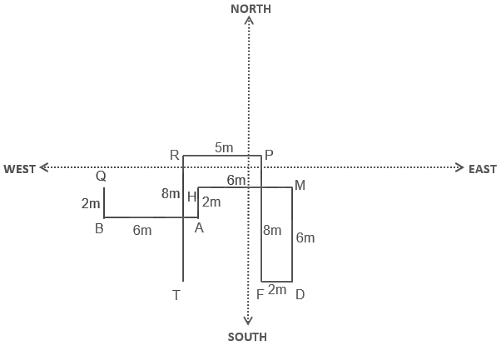IBPS RRB PO (Scale 1) Prelims Mock Test - 5 - Banking Exams MCQ
30 Questions MCQ Test - IBPS RRB PO (Scale 1) Prelims Mock Test - 5
In the given questions, the relationship between different elements is shown in the statements followed by two conclusions. Find the conclusion which is definitely true
Statements:
A > W = Y < D; S > Y ≥ Q > F
Conclusions:
I. F ≤ A
II. S ≥ W
In the given questions, the relationship between different elements is shown in the statements followed by two conclusions. Find the conclusion which is definitely true
Statements:
E = P ≥ G = O; J ≤ R < G = K > I
Conclusions:
I. J < E
II. O ≥ I
| 1 Crore+ students have signed up on EduRev. Have you? Download the App |
In the given questions, the relationship between different elements is shown in the statements followed by two conclusions. Find the conclusion which is definitely true
Statement:
Q > H = A > V ≥ J ≤ F = I
Conclusions:
I. H > I
II. J < Q
Direction: Study the following information carefully and answer the question given below.
There are seven friends A, B, C, D, E, F, and G. The seven friends have a different number of coins with them. The number of coins with them are consecutive numbers.
Further, it is known that,
1. The sum of the coins with all of them is 35.
2. The number of coins with C is the average of the number of coins with F and E.
3. G has as many coins less than B as E has less than F.
4. D has the least number of coins.
5. The sum of the coins with G and A is equal to the number of coins with C.
Q. Who has the highest number of coins?
Direction: Study the following information carefully and answer the question given below.
There are seven friends A, B, C, D, E, F, and G. The seven friends have a different number of coins with them. The number of coins with them are consecutive numbers.
Further, it is known that,
1. The sum of the coins with all of them is 35.
2. The number of coins with C is the average of the number of coins with F and E.
3. G has as many coins less than B as E has less than F.
4. D has the least number of coins.
5. The sum of the coins with G and A is equal to the number of coins with C.
Q. How many coins does E have?
Direction: Study the following information carefully and answer the question given below.
There are seven friends A, B, C, D, E, F, and G. The seven friends have a different number of coins with them. The number of coins with them are consecutive numbers.
Further, it is known that,
1. The sum of the coins with all of them is 35.
2. The number of coins with C is the average of the number of coins with F and E.
3. G has as many coins less than B as E has less than F.
4. D has the least number of coins.
5. The sum of the coins with G and A is equal to the number of coins with C.
Q. F has how many more coins than D?
Direction: Study the following information carefully and answer the question given below.
There are seven friends A, B, C, D, E, F, and G. The seven friends have a different number of coins with them. The number of coins with them are consecutive numbers.
Further, it is known that,
1. The sum of the coins with all of them is 35.
2. The number of coins with C is the average of the number of coins with F and E.
3. G has as many coins less than B as E has less than F.
4. D has the least number of coins.
5. The sum of the coins with G and A is equal to the number of coins with C.
Q. If all the friends stand from left to right in the ascending order of number coins with them, who stands third from the left?
Direction: Study the following information carefully and answer the question given below.
There are seven friends A, B, C, D, E, F, and G. The seven friends have a different number of coins with them. The number of coins with them are consecutive numbers.
Further, it is known that,
1. The sum of the coins with all of them is 35.
2. The number of coins with C is the average of the number of coins with F and E.
3. G has as many coins less than B as E has less than F.
4. D has the least number of coins.
5. The sum of the coins with G and A is equal to the number of coins with C.
Q. How many people have more coins than B?
How many such pairs of letters are there in the word “MIXTURE” each of which has as many letters between them as there are in the English alphabetical series (both forward and backward direction)?
Study the following information carefully and answer the questions given below.
Point H is 6m east of Point C. Point B is 5m north of point C and 10m east of point Y. Point S is 3m north of Point H. Point Y is 2m north of point D, which is 4m west of point Z.
Q. What is the shortest distance between the points Y and C?
Study the following information carefully and answer the questions given below.
Point H is 6m east of Point C. Point B is 5m north of point C and 10m east of point Y. Point S is 3m north of Point H. Point Y is 2m north of point D, which is 4m west of point Z.
Q. What is the direction of point S with respect to point D?
Study the following information carefully and answer the questions given below.
Point H is 6m east of Point C. Point B is 5m north of point C and 10m east of point Y. Point S is 3m north of Point H. Point Y is 2m north of point D, which is 4m west of point Z.
Q. Four of the following five are alike in a certain way as per the given arrangement and hence form a group. Find the one which doesn’t belong to that group.
Direction: In these questions, the relationship between different elements is shown in the statements. These statements are followed by two conclusions. Study the conclusions based on the given statement(s) and select the appropriate answer.
Statement:
All cars are bikes.
Some boats are bikes.
No car is a boat.
Conclusions:
I. All bikes can be boats.
II. All bikes cannot be cars.
Direction: In these questions, the relationship between different elements is shown in the statements. These statements are followed by two conclusions. Study the conclusions based on the given statement(s) and select the appropriate answer.
Statements:
Some skies are blue.
No blue is red.
Some red are water.
Conclusions:
I. Some blue can be water.
II. All water cannot be skies.
Direction: In these questions, the relationship between different elements is shown in the statements. These statements are followed by two conclusions. Study the conclusions based on the given statement(s) and select the appropriate answer.
Statements:
All dogs are dragons.
All cats are dragons.
No dragon is a lion.
Conclusions:
I. No dog can be a lion.
II. No cat can be a lion.
Direction: In these questions, the relationship between different elements is shown in the statements. These statements are followed by two conclusions. Study the conclusions based on the given statement(s) and select the appropriate answer.
Statements:
No tree is a herb.
Some shrubs are grass.
No grass is a herb.
Conclusions:
I. No shrub can be a herb.
II. No grass can be a tree.
If 1 is added to each even digit and 1 is subtracted from each odd digit in the number “2835967431”, then how many digits thus formed are repeated more than once?
If the meaningful word can be formed by using the second, fourth, seventh, and ninth letters of the word “RASPBERRY”, using each letter only once. Then what is the third letter from the left end of the newly formed word? Mark X as your answer if more than one word is formed. Mark Z if no meaningful word can be formed.
Direction: Read the following information carefully and answer the questions that follow.
Five people Tarun, Megha, Krishna, Dilip, and Sarika participated in a 100 m race. Each of them finished the race in different times and were accordingly ranked 1-5, 1 being the first person to finish the race. Each of the five participants was from a different department among Computer, Electronics, Civil, Electrical, and Mechanical.
The following information is also known:
(i) Krishna finished the race before Megha, who in turn finished the race before Sarika.
(ii) Tarun is from Mechanical while Dilip is from Electronics.
(iii) The person from the Electrical department finished the race 4th.
(iv) Tarun was one of the first three to finish the race.
(v) Sarika was from either Civil or Computer.
(vi) The person from Mechanical finished the race before the person from Electronics but not before the person from Computer.
Q. Who finished the race in the first place?
Direction: Read the following information carefully and answer the questions that follow.
Five people Tarun, Megha, Krishna, Dilip, and Sarika participated in a 100 m race. Each of them finished the race in different times and were accordingly ranked 1-5, 1 being the first person to finish the race. Each of the five participants was from a different department among Computer, Electronics, Civil, Electrical, and Mechanical.
The following information is also known:
(i) Krishna finished the race before Megha, who in turn finished the race before Sarika.
(ii) Tarun is from Mechanical while Dilip is from Electronics.
(iii) The person from the Electrical department finished the race 4th.
(iv) Tarun was one of the first three to finish the race.
(v) Sarika was from either Civil or Computer.
(vi) The person from Mechanical finished the race before the person from Electronics but not before the person from Computer.
Q. Which person belongs to the Civil Department?
Direction: Read the following information carefully and answer the questions that follow.
Five people Tarun, Megha, Krishna, Dilip, and Sarika participated in a 100 m race. Each of them finished the race in different times and were accordingly ranked 1-5, 1 being the first person to finish the race. Each of the five participants was from a different department among Computer, Electronics, Civil, Electrical, and Mechanical.
The following information is also known:
(i) Krishna finished the race before Megha, who in turn finished the race before Sarika.
(ii) Tarun is from Mechanical while Dilip is from Electronics.
(iii) The person from the Electrical department finished the race 4th.
(iv) Tarun was one of the first three to finish the race.
(v) Sarika was from either Civil or Computer.
(vi) The person from Mechanical finished the race before the person from Electronics but not before the person from Computer.
Q. Megha is from which department?
Direction: Read the following information carefully and answer the questions that follow.
Five people Tarun, Megha, Krishna, Dilip, and Sarika participated in a 100 m race. Each of them finished the race in different times and were accordingly ranked 1-5, 1 being the first person to finish the race. Each of the five participants was from a different department among Computer, Electronics, Civil, Electrical, and Mechanical.
The following information is also known:
(i) Krishna finished the race before Megha, who in turn finished the race before Sarika.
(ii) Tarun is from Mechanical while Dilip is from Electronics.
(iii) The person from the Electrical department finished the race 4th.
(iv) Tarun was one of the first three to finish the race.
(v) Sarika was from either Civil or Computer.
(vi) The person from Mechanical finished the race before the person from Electronics but not before the person from Computer.
Q. Which of the following correctly matches the person with his/her department and rank?
Study the following information carefully and answer the questions given below.
In a certain code language,
“Hotel manager supervise work” is coded as “ro ik zd lh”
“Manager supervise loan section” is coded as “ag lh fn ik”
“Loan sanction for hotel” is coded as “fn lz zd gj”
“They seek for loan” is coded as “fn lz iu sf”
Q. Which of the following phrase denotes the code “lh gj” in the given code language?
Study the following information carefully and answer the questions given below.
In a certain code language,
“Hotel manager supervise work” is coded as “ro ik zd lh”
“Manager supervise loan section” is coded as “ag lh fn ik”
“Loan sanction for hotel” is coded as “fn lz zd gj”
“They seek for loan” is coded as “fn lz iu sf”
Q. What is the code for the phrase “loan section” in the given code language?
Study the following information carefully and answer the questions given below.
In a certain code language,
“Hotel manager supervise work” is coded as “ro ik zd lh”
“Manager supervise loan section” is coded as “ag lh fn ik”
“Loan sanction for hotel” is coded as “fn lz zd gj”
“They seek for loan” is coded as “fn lz iu sf”
Q. What is the code for the word “sanction” in the given code language?
Study the following information carefully and answer the questions given below.
In a certain code language,
“Hotel manager supervise work” is coded as “ro ik zd lh”
“Manager supervise loan section” is coded as “ag lh fn ik”
“Loan sanction for hotel” is coded as “fn lz zd gj”
“They seek for loan” is coded as “fn lz iu sf”
Q. What is the code for the phrase “they work hotel” in the given code language?
Direction: Study the information given below carefully and answer the questions that follow.
A is 6m east of B. Q is 2m north of B. H is 6m west of M. A is 2m south of H. R is 5m west of P. D is 2m east of F. T is 8m south of R. M is 6m north of D. F is 8m south of P.
Q. What is the position of M with respect to Q?
Direction: Study the information given below carefully and answer the questions that follow.
A is 6m east of B. Q is 2m north of B. H is 6m west of M. A is 2m south of H. R is 5m west of P. D is 2m east of F. T is 8m south of R. M is 6m north of D. F is 8m south of P.
Q. What is the position of B with respect to D?
Direction: In the following question assuming the given statements to be true, find which of the conclusion among given conclusions is/ are definitely true and then give your answers accordingly.
Statement: P > Q > R; R < S > T; T = U > V
Conclusions:
I. R = V
II. P > S
Direction: A statement is given followed by two inferences I and II. You have to consider the statement to be true even if it seems to be at variance from commonly known facts. You have to decide which of the given inferences, if any, follow from the given statement.
Statement: Security of the building was increased after the incident at the old lady's apartment.
Assumptions:
I. Something dangerous happened at the old lady's apartment.
II. The old lady was an easy target.


